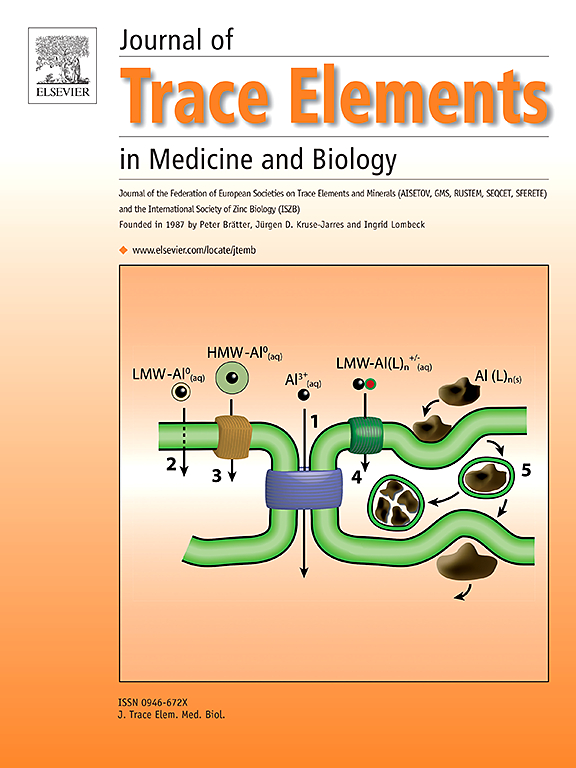Pro-inflammatory diet affects markers of iron metabolism in healthy older adults
IF 3.6
3区 医学
Q2 BIOCHEMISTRY & MOLECULAR BIOLOGY
Journal of Trace Elements in Medicine and Biology
Pub Date : 2025-02-01
DOI:10.1016/j.jtemb.2024.127583
引用次数: 0
Abstract
Background
Inflammation and inadequate nutrition are common in older age and known to affect iron homeostasis. However, it is not known whether a pro-inflammatory diet affects iron status in older adults. We investigated the diet quality of healthy older adults considering markers of iron homeostasis and inflammation compared to a younger control.
Methods
Serum markers of iron metabolism (iron, transferrin, ferritin, hepcidin, soluble transferrin receptor [sTfR]) and inflammation (interleukin-6 [IL-6], IL-10 high-sensitive C- reactive protein [hsCRP]) were quantified using immunosorbent assays. Insulin resistance was determined by calculating the homeostasis model assessment index (HOMA-IR). The Dietary Inflammatory Index® (DII) was computed based on dietary intake and inflammatory (ID) or less inflammatory diet (LID) groups were created by using median DII score specific to age group and sex.
Results
DII did not differ by age (p = 0.668, n = 80, F: 75 %, >65 years, n = 60, F: 72 %, ≤35 years). Iron and inflammation status were different between age groups in terms of higher transferrin saturation, sTfR, ferritin and IL-6 concentrations in the old (all p ≤ 0.001). Only in older adults, BMI, HOMA-IR, hsCRP, ferritin and hepcidin concentrations were significantly higher in ID compared to LID (all p < 0.01). In addition, a risk-factor adjusted regression analysis showed that ID was independently associated with higher ferritin and hepcidin concentrations in older adults.
Conclusion
In older age, a pro-inflammatory diet is associated with systemic inflammation and disturbed iron homeostasis.
促炎饮食影响健康老年人铁代谢标志物。
背景:炎症和营养不足在老年人中很常见,并且已知会影响铁的体内平衡。然而,目前尚不清楚促炎饮食是否会影响老年人的铁含量。我们研究了健康老年人的饮食质量,考虑了铁稳态和炎症的标志物,并与年轻的对照组进行了比较。方法:采用免疫吸附法测定血清铁代谢指标(铁、转铁蛋白、铁蛋白、肝磷脂、可溶性转铁蛋白受体[sTfR])和炎症指标(白细胞介素-6 [IL-6]、IL-10高敏C反应蛋白[hsCRP])。通过计算稳态模型评估指数(HOMA-IR)来确定胰岛素抵抗。膳食炎症指数®(DII)是根据膳食摄入量计算的,炎症(ID)或低炎症饮食(LID)组是根据特定年龄组和性别的中位数DII评分来划分的。结果:DII无年龄差异(p = 0.668,n = 80,F: 75 %,>65岁,n = 60,F: 72 %,≤35岁)。不同年龄组的铁和炎症状态在老年人较高的转铁蛋白饱和度、sTfR、铁蛋白和IL-6浓度方面存在差异(均p ≤ 0.001)。仅在老年人中,ID组的BMI、HOMA-IR、hsCRP、铁蛋白和hepcidin浓度显著高于LID组(均p )。结论:在老年人中,促炎饮食与全身性炎症和铁稳态紊乱有关。
本文章由计算机程序翻译,如有差异,请以英文原文为准。
求助全文
约1分钟内获得全文
求助全文
来源期刊
CiteScore
6.60
自引率
2.90%
发文量
202
审稿时长
85 days
期刊介绍:
The journal provides the reader with a thorough description of theoretical and applied aspects of trace elements in medicine and biology and is devoted to the advancement of scientific knowledge about trace elements and trace element species. Trace elements play essential roles in the maintenance of physiological processes. During the last decades there has been a great deal of scientific investigation about the function and binding of trace elements. The Journal of Trace Elements in Medicine and Biology focuses on the description and dissemination of scientific results concerning the role of trace elements with respect to their mode of action in health and disease and nutritional importance. Progress in the knowledge of the biological role of trace elements depends, however, on advances in trace elements chemistry. Thus the Journal of Trace Elements in Medicine and Biology will include only those papers that base their results on proven analytical methods.
Also, we only publish those articles in which the quality assurance regarding the execution of experiments and achievement of results is guaranteed.

 求助内容:
求助内容: 应助结果提醒方式:
应助结果提醒方式:


